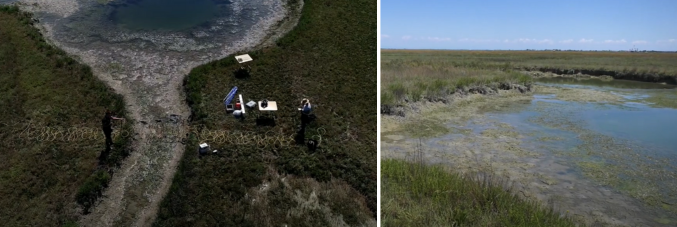
Venice Lagoon. The salt marshes and their network of channels and meanders
09.05.2023
Salt marshes are dissected by extensive networks of channels that are formed by the periodicaction of tides. Besides representing the preferential route for tide propagation, these channel networks are quintessential both for the conservation and evolution of the salt marshes, as well as for a series of ecosystem services that they provide. For example, they represent a preferential breeding area for local fish species.
Moreover, these channels are a biodiversity hotspot because thanks to the presence of the salt marshes, which provide sheltering from the action of wind and the strongest tidal currents and waves.
Historically these networks of tidal channels have been considered planimetrically stable geomorphological features; that is, their shape and spatial distribution over time were thought not to change substantially.
In fact, through more in-depth analyzes and above all thanks to the increase in resolution of the satellite and aerial images that we can rely on today, we have been able to observe that these channels are highly dynamic and their morphology tends to change over time, sometimes quite significantly.
The study of the dynamics of these channels is a relatively recent line of research that is of interest not only for salt marshes found in lagoonal areas, such as these ones in the Venice Lagoon, but also for deltaic regions area such as, for example, the salt marshes of Mississippi Delta or of the Ganges River", explains Alvise Finotello, researcher of the Department of Geosciences of the University of Padova.
"Meandering channels, those characterized by an extremely complex and sinuous shape, have always been one of the major points of interest for both geomorphologists and sedimentologists. The reasons are various: in a lagoon environment these meanders are an essential element of the landscape, they substantially constitute arteries of the system and are responsible for the exchange of water and nutrients between the lagoon environment and the sea. Furthermore theyoffer different types of ecosystem services", adds Massimiliano Ghinassi, associate professor of the Department of Geosciences of the University of Padova.
Shooting and editing by Barbara Paknazar
Drone videos by Stefano Castelli
The previous episodes are available here:
1) Venice Lagoon. The morphology of the largest tidal basin in the Mediterranean
2) Venice Lagoon. The salt marshes and what they need to survive
3) Venice Lagoon. Ecosystem services provided by salt marshes
4) Venice Lagoon. Analyzing salt marsh soils in laboratory





